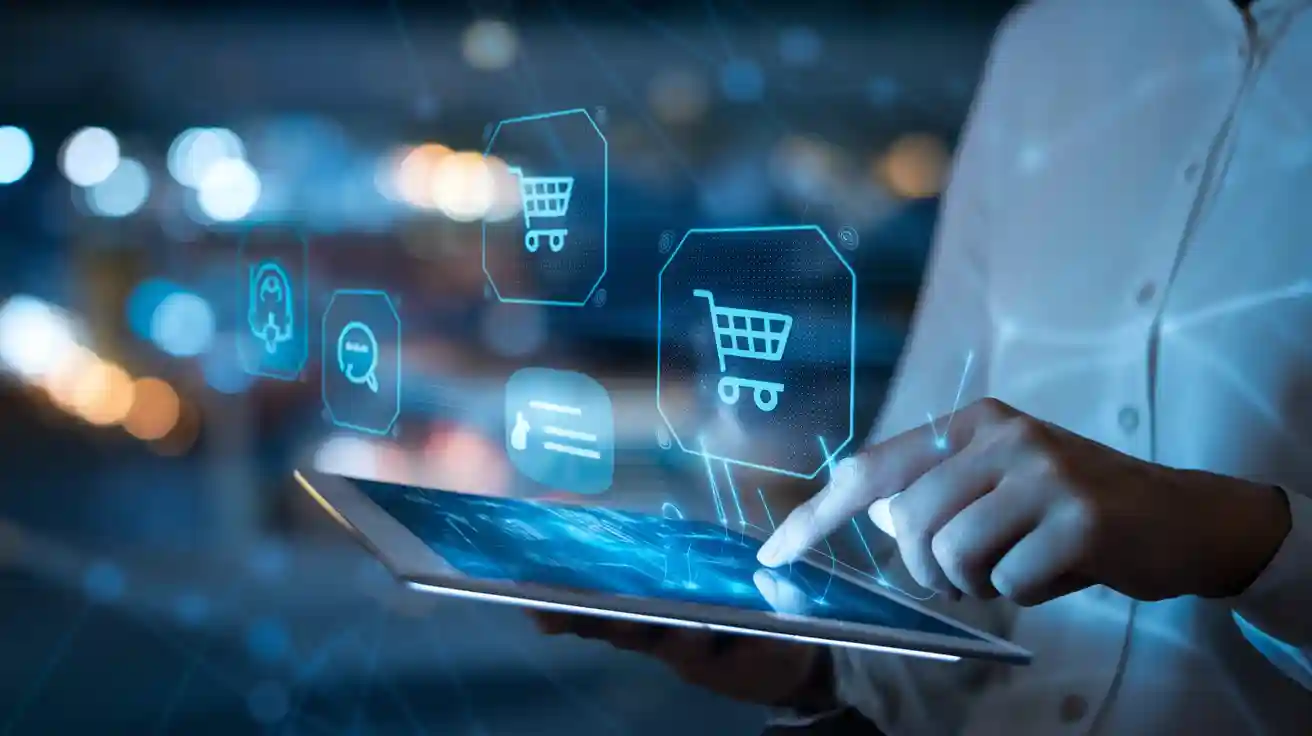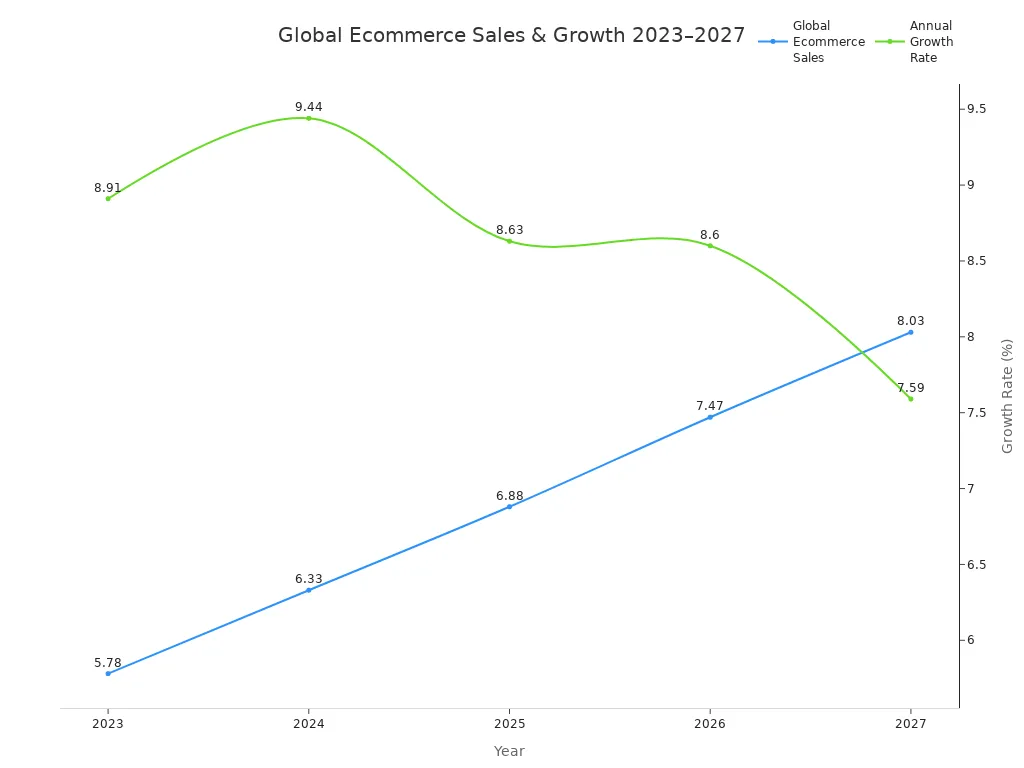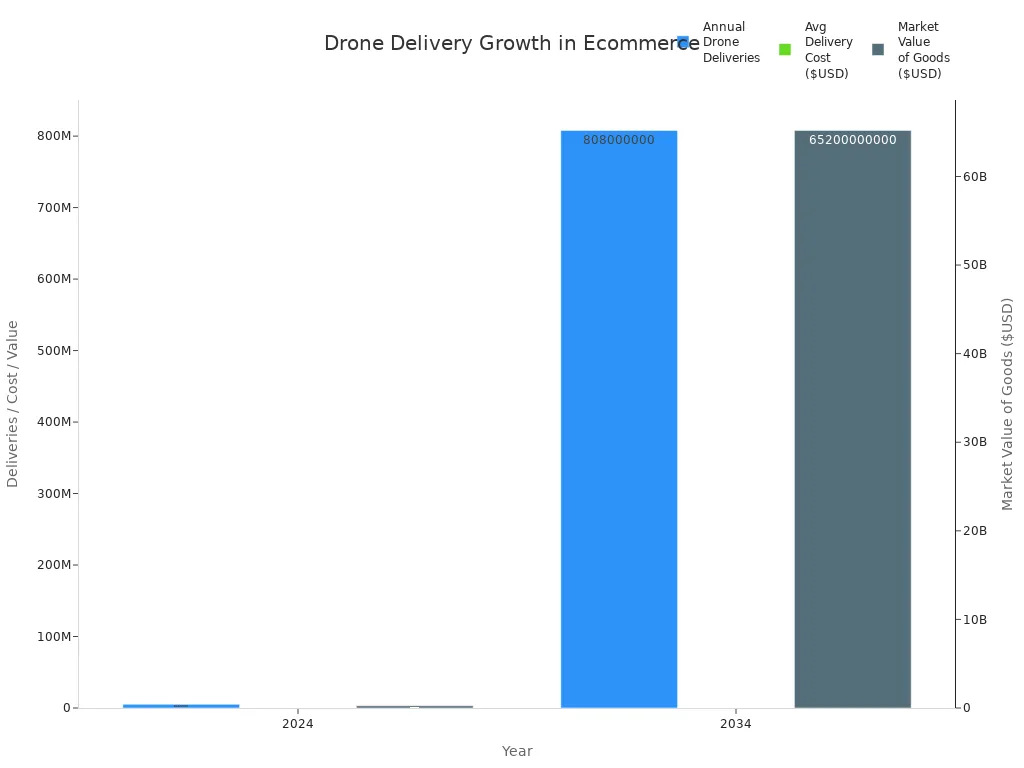
Ecommerce continues to reshape how businesses reach customers and how consumers approach online shopping. The market shows rapid growth, with global ecommerce sales expected to reach $8.03 trillion by 2027.
| Year | Projected Global Ecommerce Sales (Trillions USD) | Annual Growth Rate (%) |
|---|---|---|
| 2023 | 5.78 | 8.91 |
| 2024 | 6.33 | 9.44 |
| 2025 | 6.88 | 8.63 |
| 2026 | 7.47 | 8.60 |
| 2027 | 8.03 | 7.59 |

Mobile commerce, social engagement, and omnichannel strategies lead current trends, driving a major change in both customer expectations and business strategies. As the future of ecommerce unfolds, every customer and business will feel the impact on their daily experience.
Future of Ecommerce Trends

AI & Automation
AI and automation stand at the forefront of e-commerce trends, driving rapid transformation across the industry. Businesses now use machine learning algorithms to analyze vast amounts of data, predict shopping patterns, and automate decisions. These technologies help companies personalize the customer experience, boost conversion rates, and streamline operations. For example, AI-powered chatbots and virtual assistants provide 24/7 customer support, answering questions and resolving issues instantly. Natural language processing allows these digital assistants to understand and respond to customer needs, improving satisfaction and loyalty.
Robotics and automation have revolutionized inventory management and order fulfillment. Warehouses now use robots to pick, pack, and ship products, reducing errors and speeding up delivery times. Computer vision technology helps with product discovery and fraud detection, making online shopping safer and more efficient. AI-driven analytics offer deep insights for demand forecasting, pricing optimization, and supply chain management. This level of automation frees human staff to focus on creative and strategic tasks, increasing productivity.
The market for AI-enabled ecommerce solutions continues to grow. According to recent projections, the value of AI-driven ecommerce solutions could reach up to $8.65 billion by 2025, with conversational commerce alone expected to hit $8.8 billion. These numbers highlight the central role of AI in shaping the future of ecommerce and e-commerce trends.
AI and automation not only improve efficiency but also create new opportunities for businesses to deliver a seamless, personalized customer experience.
Social Commerce
Social commerce has emerged as one of the most influential ecommerce trends, blending social media engagement with direct shopping experiences. Platforms like Instagram, Facebook, TikTok, and Pinterest now offer features such as shoppable posts, in-app checkouts, and live-stream shopping events. These tools allow users to discover, evaluate, and purchase products without leaving their favorite apps, reducing friction and shortening the path from discovery to purchase.
| Platform | Social Commerce Features | Direct Shopping Experience |
|---|---|---|
| Shoppable posts, Instagram Shops, In-App Checkout | Users browse and buy products without leaving the app, simplifying the journey and reducing cart abandonment. | |
| Marketplace, Shops integrated with Shopify | Businesses sell directly on the platform with customized storefronts and manage sales across Facebook and Instagram. | |
| TikTok | In-video product links, TikTok Shop, live-stream shopping | Users discover and purchase products within engaging video content, capitalizing on trends and viral marketing. |
| Buyable Pins, Pinterest Shops, Shopify sync | Visual product discovery and direct purchases, especially effective for fashion, home decor, and DIY niches. |
Social commerce now accounts for about 17% of all ecommerce sales worldwide. In 2024, global revenue from social commerce reached $683 billion, with projections to hit $1 trillion by 2029. This rapid growth shows how social platforms have become essential sales channels for brands and retailers.
Livestream shopping events, augmented reality try-ons, and AI-driven product recommendations make social commerce more interactive and personalized. Influencer marketing and social proof build trust, encouraging consumers to try new products. These features create a seamless, engaging, and convenient shopping environment, making social commerce a key driver in the future of ecommerce.
Mobile Shopping
Mobile shopping continues to dominate e-commerce trends, with more consumers choosing smartphones and tablets for their online purchases. In 2024, mobile devices accounted for nearly 60% of global web traffic and 59% of ecommerce sales, while desktop devices made up about 41%. Consumers prefer mobile shopping for its portability, convenience, and constant connectivity.
| Metric/Aspect | Mobile Usage | Desktop Usage |
|---|---|---|
| Share of global eCommerce sales | 59% ($4.01 trillion) | Nearly 41% |
| Conversion rate | 2.9% | 4.8% |
| Impulse buying rate | 30% higher than desktop | Lower impulse buying rate |
| Web traffic share | Nearly 60% | Nearly 40% |
Mobile shopping apps play a crucial role in shaping consumer behavior. Brands like Nike have seen revenue nearly double over ten years, partly due to their mobile app strategies. Consumers show a strong preference for apps, with 85% favoring them over mobile websites. Apps allow users to view more products, add items to carts more often, and enjoy a streamlined checkout process with saved payment methods. This leads to a 130% higher conversion rate compared to mobile websites.
Mobile payment options such as Apple Pay and Google Pay reduce checkout friction, further boosting conversions. Push notifications and personalized experiences keep customers engaged and loyal. Augmented reality shopping and voice commerce are also gaining popularity, making mobile shopping more interactive and convenient.
Mobile shopping is not just a trend—it is a fundamental shift in how consumers interact with brands and make purchasing decisions. Businesses that invest in mobile-first strategies will stay ahead in the evolving digital marketplace.
E-commerce Customer Experience
Personalization
Personalization has become a core driver of ecommerce growth. Retailers now use ai-powered personalization to deliver hyper-personalized shopping experiences. AI-driven personalization tools analyze customer behavior and preferences, offering tailored product recommendations and dynamic website content. These systems adjust homepage banners, featured collections, and offers based on each customer’s journey. Personalized search results help users find products faster, while behavioral triggers send timely reminders for abandoned carts. Customized checkout experiences reduce friction and increase satisfaction. Studies show that ai-driven product recommendations can boost conversion rates by up to 915% and raise average order values by 3%. Nearly 45% of shoppers prefer ecommerce sites that offer personalization. By 2030, ai-powered ecommerce personalization is expected to increase retailer revenue by 30%. Voice commerce and AR/VR will further enhance personalized recommendations and engagement.
Omnichannel
Omnichannel strategies have transformed e-commerce by creating seamless customer experiences across every touchpoint. Customers can browse, add to cart, and purchase through websites, apps, email, or social channels without disruption. Omnichannel ecommerce uses unified data to provide real-time information, integrated customer service, and tailored offers. Brands deliver consistent messaging and branding, which strengthens trust and loyalty. AI and big data help synchronize inventory and personalize communication. Studies show that omnichannel strategies improve satisfaction, retention, and repeat purchases. Brands like Nike and Sephora use omnichannel approaches to connect with customers wherever they shop.
Live Shopping
Live shopping events are changing how customers interact with ecommerce brands. China leads this trend, with live commerce making up over 19% of total retail e-commerce sales. The US market is growing quickly, projected to reach $55 billion by 2026. In Europe, 35% of consumers have joined livestream shopping experiences. Major brands such as Amazon, Walmart, and Sephora now host live shopping programs. These events allow customers to ask questions, see products in real time, and receive personalized recommendations. Live shopping creates excitement and builds trust, making it a powerful tool for ecommerce engagement.
Chatbots
AI-powered chatbots have become essential in e-commerce customer service. These bots provide 24/7 support, answer questions instantly, and resolve issues faster than traditional methods. Chatbots use ai-driven personalization to engage customers based on their previous interactions and preferences. They qualify leads, route queries, and handle routine tasks, allowing human agents to focus on complex cases. Studies show that chatbots can increase ecommerce sales conversion by 23% and resolve issues 18% faster. Brands like Zappos and Sephora use chatbots to deliver immediate, personalized help, which improves satisfaction and loyalty. Chatbots also reduce operational costs and help build seamless customer experiences.
Payments & Delivery in Ecommerce
Frictionless Payments
Frictionless payment technologies have transformed the e-commerce landscape. Customers expect fast, secure, and convenient transactions. Many platforms now offer mobile wallets like Apple Pay, Google Pay, and Samsung Pay. These wallets use NFC technology, which speeds up payments and reduces fraud. Click To Pay lets shoppers store card information securely and pay quickly without exposing sensitive data. Contactless payment cards allow tap-to-pay, making checkout even easier. Buy Now, Pay Later (BNPL) services give customers the option to pay in installments, often interest-free, increasing purchasing flexibility. Voice ordering through smart devices such as Amazon Alexa enables hands-free shopping. Biometric authentication, including fingerprint and facial recognition, adds another layer of security. These advancements reduce cart abandonment and boost customer satisfaction in ecommerce.
Frictionless payments help e-commerce businesses build loyalty by making every transaction smooth and secure.
Subscription Models
Subscription models have become a powerful tool in ecommerce. They create predictable, recurring revenue streams and shift the focus from one-time sales to long-term relationships. Businesses track key metrics like Monthly Recurring Revenue (MRR), Average Revenue Per User (ARPU), and churn rate to optimize performance. Subscription models include curated boxes, replenishment services, and exclusive memberships. These options provide convenience and personalized experiences, which increase customer loyalty. Companies using subscriptions grow more than five times faster than the S&P 500. Repeat customers spend 67% more than new ones, showing the value of retention. The ecommerce subscription market is projected to reach $539.16 billion by 2025.
- Subscriptions automate regular purchases, saving time for customers.
- Memberships offer perks and early access, building a sense of community.
- Personalized experiences keep customers engaged and satisfied.
Drone Delivery
Drone delivery is changing how e-commerce companies handle logistics. In 2024, drones completed about 14,000 deliveries daily, with projections reaching 5 million per day worldwide. By 2034, annual B2C drone deliveries could hit 808 million. The average cost per delivery is expected to drop from $6–$25 today to around $2 in 2034. Drones also help the environment, with one drone saving up to 45 tons of CO2 emissions each year. Adoption moves faster in suburban and rural areas due to fewer obstacles. Companies like Amazon and Walmart use drones to deliver packages in under an hour, improving last-mile delivery and expanding market reach.

Supply Chain
Ecommerce companies use advanced technology to optimize supply chains. IoT, AI, and blockchain provide real-time visibility and better decision-making. Warehouse automation, including robotics and Automated Storage and Retrieval Systems (AS/RS), speeds up picking and packing. Just-In-Time inventory and demand forecasting help balance stock levels, reducing costs. Transportation Management Systems (TMS) optimize delivery routes and carrier choices. Local fulfillment centers and real-time tracking improve last-mile delivery. For example, CorneaCare used route optimization to achieve 30% faster delivery and 20% lower costs. These strategies help e-commerce businesses deliver products quickly and efficiently, meeting rising customer expectations.
Trust & Sustainability in E-commerce

Data Privacy
Data privacy stands as a top concern for every e-commerce customer. Many shoppers worry about personal information leakage, stolen login credentials, and credit card fraud. Some websites lack proper encryption, which increases risks when customers share sensitive data. Phishing attacks often trick people into revealing private details by pretending to be trusted companies.
- Customers should use secure payment methods.
- Avoid public Wi-Fi for shopping.
- Log out after purchases.
- Review credit card statements for unauthorized charges.
Most consumers hesitate to share personal data with commercial apps. Many dislike behavioral advertising that feels invasive or embarrassing. Privacy concerns can reduce loyalty and affect how people respond to e-commerce ads. Laws like GDPR and the California Privacy Act give customers more control. Tech leaders such as Apple and Alphabet now offer stronger privacy controls. Informed customers take steps to protect themselves, balancing convenience and safety.
Eco-Friendly Practices
E-commerce companies now focus on eco-friendly practices to meet customer expectations and reduce environmental impact.
| Company | Eco-Friendly Practice(s) |
|---|---|
| Everlane | Blockchain for supply chain transparency and ethical sourcing. |
| Loop | Reusable packaging to cut waste. |
| Amazon | Reduced packaging, electric vehicles, net-zero carbon goal by 2040. |
| Patagonia | Product repair, organic cotton, environmental data analytics. |
| Allbirds | Sustainable materials, transparent supply chain, consumer education. |
Many brands use biodegradable packaging, minimize waste, and adopt renewable energy. Route optimization and electric vehicles help lower emissions. These steps show how e-commerce can support a greener future.
Ethical Sourcing
Ethical sourcing builds trust and protects both the business and the consumer.
- Most consumers want ethical sourcing, so companies must act responsibly.
- Laws like the Modern Slavery Act require transparency and reporting.
- Ethical sourcing reduces risks from labor violations and environmental harm.
- Strong supplier relationships and regular audits improve supply chain resilience.
- Training and technology, such as blockchain, help maintain high standards.
Brands that invest in ethical sourcing gain loyalty and avoid legal trouble.
Building Trust
Trust forms the foundation of every e-commerce relationship. Transparency about products, pricing, shipping, and returns matters to customers.
- 64% of women say accurate product descriptions are most important.
- 55% of shoppers get frustrated by poor information.
- 94% of consumers stay loyal to transparent brands.
Visible customer reviews, even negative ones, help others make informed choices. Brands like Everlane and Warby Parker use transparency to build loyal customer bases.
Transparency and honest communication lead to higher satisfaction, repeat purchases, and a strong reputation in e-commerce.
New Business Models in E-commerce
B2B Ecommerce
B2B ecommerce is transforming how businesses buy and sell products. Digital platforms now connect manufacturers, wholesalers, and retailers, making transactions faster and more transparent. Marketplaces such as Siemens’ Enterprise Marketplace and OmniRetail help companies streamline supply chains and improve efficiency. These platforms offer real-time inventory management, automated order processing, and data insights for better decision-making. Mobile-first design and omnichannel integration allow buyers to shop anytime and anywhere. Companies that use digital self-service portals and AI-driven automation reduce errors and speed up delivery. The Asia Pacific B2B ecommerce market is growing quickly, with a projected annual growth rate of 25% through 2030. This shift in the retail value chain helps businesses reach new markets and adapt to changing customer needs.
Branding & Loyalty
Branding and loyalty strategies play a key role in ecommerce success. Companies use omnichannel consistency to give customers a seamless experience across all touchpoints. Loyalty programs reward repeat purchases and encourage customers to return. Personalized offers, thank-you notes, and proactive customer service make shoppers feel valued. Brands that focus on sustainability see higher repeat rates and stronger emotional connections. Green loyalty programs, such as those that reward eco-friendly actions, boost engagement. User-generated content and limited-edition collaborations create excitement and community. Gamified loyalty programs with tiers and challenges keep customers interested over time.
Digital Marketing
Digital marketing tactics continue to evolve as ecommerce grows. Brands use AI tools to personalize shopping experiences and increase engagement. Data analytics help companies understand customer behavior and predict trends. Real-time messaging and automation allow businesses to adapt quickly to customer preferences. Multichannel strategies reach shoppers on social media, email, websites, and even physical stores. Companies that monitor consumer insights and competitor actions stay ahead in the fast-changing digital marketplace. Agility and responsiveness are now essential for digital business transformation.
Hyperlocal Strategies
Hyperlocal strategies focus on serving customers within a specific area. Ecommerce businesses use local marketplaces to offer faster deliveries and a wider product range. Working with local vendors supports the community and improves sustainability by reducing delivery distances. Personalized experiences and strong social proof from local customers build trust and loyalty. However, scaling logistics and maintaining reliable supply chains can be challenging. Companies must invest in technology and data-driven personalization to meet local needs. Hyperlocal approaches help brands respond quickly to local trends and stand out in competitive markets.
New business models in ecommerce drive innovation and reshape how companies connect with customers, manage supply chains, and build loyalty.
The future of ecommerce will be shaped by rapid innovation and changing consumer demands. Businesses and consumers can adapt by following these steps:
- Optimize for mobile commerce and fast loading.
- Personalize shopping using data analytics.
- Embrace sustainability in sourcing and packaging.
- Adopt new technologies like AI and AR.
- Improve customer experience with seamless navigation and feedback.
Staying informed about trends and embracing new tools will help companies remain competitive as ecommerce continues to evolve.
FAQ
What role does AI play in the future of ecommerce?
AI helps companies predict trends, personalize shopping, and automate customer service. Businesses use AI to improve product recommendations and manage inventory. AI-driven chatbots answer questions quickly.
AI makes online shopping faster and more personal for everyone.
How can ecommerce businesses build customer trust?
Companies build trust by sharing clear product details, offering secure payments, and showing real customer reviews.
- Transparent return policies help customers feel safe.
- Brands that communicate openly earn more loyalty.
Why is mobile shopping important for ecommerce growth?
Mobile shopping lets customers buy products anytime and anywhere. Most shoppers use smartphones for browsing and purchases.
Mobile apps offer faster checkouts and personalized deals, making shopping easier and more enjoyable.
What are some eco-friendly practices in ecommerce?
Many brands use recyclable packaging, reduce waste, and choose renewable energy.
| Practice | Example |
|---|---|
| Reusable boxes | Loop |
| Electric delivery | Amazon |
| Organic materials | Allbirds, Patagonia |
These steps help protect the environment and attract eco-conscious shoppers.
How do subscription models benefit ecommerce companies?
Subscription models create steady income and stronger customer relationships.
- Customers receive products regularly.
- Companies can predict sales and plan better.
- Subscribers often spend more over time.
Subscriptions help businesses grow and keep customers coming back.
See Also
The Role Of Micro Fulfillment Centers In E-Commerce Expansion
Strategies To Secure Long-Term Success In B2B Fulfillment
Is Overflow Warehousing Key To Supporting E-Commerce Growth
The Importance Of SaaS WMS For Modern Warehouse Innovation
How Blind Shipping Enhances Efficiency For E-Commerce Retailers